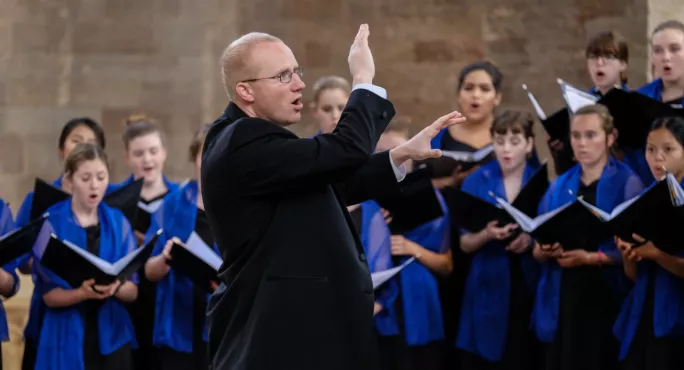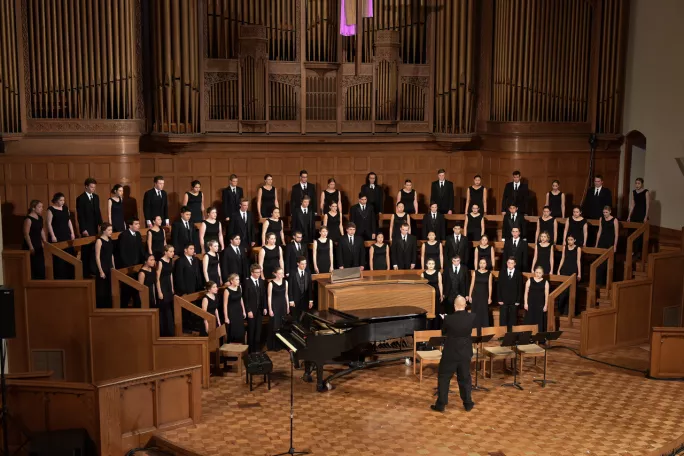- Home
- A day in the teaching life of...Keith Hancock
A day in the teaching life of...Keith Hancock

The wonderful thing about life as a choir director is that no two days are alike. I always have a plan in place and a structure to the way the class is run, but a big part of my job teaching at Tesoro High School in California is responding real time to what the choir is giving me.
We start with a vocal warm-up, similar to an athlete stretching before a race. This is a chance for me to discuss vocal technique, breathing, resonance, and other concepts important to every student’s development as a singer. Since most of my students don’t take private voice lessons, I’m the only singing teacher they may ever have.
After warm-ups, we spend some time listening to a song from a musical style they likely aren’t too familiar with, such as classical, jazz, world music, or musical theatre. The goal is that in four years, each of my students will have exposure and a great appreciation, though not necessarily a love, for a wide variety of music. This time is also a great opportunity to reinforce some musical concepts, as the students all respond in writing to the music giving their personal opinions and identifying tempo, time signature, tonality, and instruments used.
Following the listening time, we work on each student’s musicianship, which in my class is broken up into music theory and sight singing. My beginning and intermediate students need much more of the “basics,” such as note names, rhythmic values, dynamic markings, and intervals since this is the first music class many of them have taken. My advanced students work on more challenging theory concepts such as key signatures, what notes make up the kinds of chords that exist, and advanced ear training.
We will then move into some instruction to help my students improve in their music reading ability. Just like it is an elementary school teacher’s job to teach students how to read, it is a music teacher’s job to teach the students how to read music. It is similar to learning a foreign language, and sight-reading skills must be sequentially taught to ensure success for a classroom of students who have a variety of ability and experience.
I use a system of teaching sight singing called “solfege”. This system of assigning syllables to each note in the chromatic scale (do, re, mi, etc.) coupled with assigning syllables to each rhythmic value (ta for quarter notes, ti for eighth notes, etc.) makes it easier for a beginning music student to understand the process. Sight singing music is a very difficult skill to learn, especially when the students don’t have any piano experience, but with patience and determination, students can grow significantly in their music reading skills over the course of their time in my class.

Since our school is on a modified block schedule, I only see three of my six classes on any given day, while the remaining three classes I see the following day. Therefore, each class period on our block schedule days is about 100 minutes long. This has advantages and disadvantages, but for me, the pros outweigh the cons. One of the big pros is that after all of the aforementioned activities in class, we still usually have over an hour for music rehearsal where we are learning our music for our upcoming concert, of which we give five per year.
After our choir announcements, we then move into the rehearsal portion of our class when we practice three or four pieces for our concert. I would estimate we get five or six hours per song. In that amount of time, there are so many different musical concepts to teach. At the very basic level, there are notes, rhythms, and lyrics to learn. Those lyrics are often in a foreign language since I make it a point to expose my students to repertoire from around the world. This means that not only do the students need to know what the words mean to adequately understand and be able to convey the emotion of the piece, but they also need to know exactly how to pronounce each syllable. This can be particularly challenging when dealing with languages that use different sounds than we do. Once the basics are taken care of, it is time for my favourite part, shaping the music. This is where all the detail work is done as we work on breathing at the right time, varying the dynamics (volume) throughout the piece, matching vowel shapes, strengthening tone, balancing the choir, and working on singing perfectly in tune.
The challenges I face in my situation are related to the size and makeup of my classes. Some of my classes have over 60 students, and all of my classes, though largely grouped by overall ability, have a wide spectrum within each skill. In any class, we have some that have strong voices, some that read well, and some with good ears. Teaching to ensure that every child is learning well is a tall task, but it is one that I am constantly refining my approach to achieve my curricular goals. Regardless of the frustrations that may appear day-to-day, when I see the culmination of the hard work in our performances and the pride in the faces of my students, I can rest assured that I have done my job well.
Keith Hancock is the choral music director at Tesoro High School, California.
Keep reading for just £1 per month
You've reached your limit of free articles this month. Subscribe for £1 per month for three months and get:
- Unlimited access to all Tes magazine content
- Exclusive subscriber-only stories
- Award-winning email newsletters